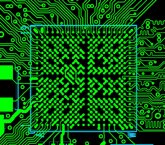PCB design at Bluewater is most of the time an exciting challenge, especially when it comes with system modules. Just like with any other modern digital gadgets nowadays, they have to be small in size and thus, space (or real estate as another term used by PCB designers) on a PCB is always a premium. Along with this direction, the chain must adapt to it, small fine-pitch and high density components are mostly used, PCB vendors have to update their capability, as well as PCB assembly houses. And of course, cost will always be involved when going to miniature, complicated technology. Otherwise, these modern tiny gadgets will never exist. Speaking of fine-pitch high density components, things like 0.5 to 0.65mm pitch BGA packages should usually surface as a common option along with fine-pitch packages such as QFN, DFN, etc. The thing with fine-pitch BGAs, especially full-matrix ones, is that they are usually more difficult to fan-out (so that you can route to the rest of the circuitry on the PCB) compared to conventional0.8 to 1mm pitch BGAs. High-tech PCB technologies such as Two year ago, we developed a module (37mm x 26mm) with Intel's PXA272 microprocessor (0.65mm-pitch, 336 pins, full matrix BGA) on it for our customer (in military defence). With cost in mind and by coordinating with our PCB vendor, we were able to avoid the costly high-tech HDI or blind/buried microvias, or via-in-pad by using 5-mil via through-hole drill/15-mil via pad and 3-mil spacing between vias to any other entities but with limited aspect ratio. Although this approach may still not fall under (still slightly expensive) the conventional PCB technologies and is dependent of our PCB vendor, at least it's not a full blown HDI or any other costly cutting edge PCB technology and it's good to know that there are less costly options like this, especially when just producing prototype quantities. In our Snapper 270 SOM, we also have buffers having 0.65mm pitch but not full-matrix ones and we were able to use full conventional PCB technology by carefully assigning signals on the buffer side to eliminate vias in fanning out the BGA and optimised routing. Most recently, we are currently developing our Snapper-DV board, which is using Texas Instrument's Da Vinci processor TMS320DM355, a full-matrix, 377 pin, 0.65mm pitch BGA and again, the same above mentioned strategy were used to check cost and this time around, with an improved aspect ratio, thanks to our PCB vendor.  In the near future, HDI and the like may be the only way to go but hopefully, the cost tagged along with using these cutting-edge technologies will trick down (fingers crossed).
In the near future, HDI and the like may be the only way to go but hopefully, the cost tagged along with using these cutting-edge technologies will trick down (fingers crossed).

Bluewater, PCB Design & Fine-Pitch BGAsPosted in Hardware design on September 26, 2008 by Janus Patalinjug |



